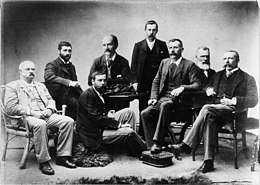Horn expedition
The Horn Scientific Expedition was the first primarily scientific expedition to study the natural history of Central Australia, sponsored by three Australian universities (University of Sydney, University of Adelaide and University of Melbourne).[1] It took place from May to August 1894, with expedition members first traveling by train from Adelaide to the railhead at Oodnadatta in South Australia, then using camels for transport to traverse over 3000 km of largely uncharted country from Oodnadatta through the Finke River basin to Alice Springs and the Macdonnell Ranges in the Northern Territory.

The expedition was equipped and sponsored by William Austin Horn, a wealthy pastoralist and mining magnate, who accompanied the expedition in its early stages. The area studied included the country of the Arrernte and Luritja people, whose assistance and goodwill was crucial to the success of the expedition through the provision of natural history specimens, artefacts and information.[2]
Personnel
Members of the expedition,[3] with their responsibilities, included:
- Professor Baldwin Spencer – zoology and photography, who also edited the official account of the expedition for publication
- Dr Edward Charles Stirling – anthropology, who acted as the medical officer
- Professor Ralph Tate – geology and botany
- J. A. Watt – geology and mineralogy
- Charles Winnecke – meteorology, as well as being the surveyor and leader
Other personnel were two collectors, one of whom was ornithologist George Keartland, a cook and four cameleers.[4] Local Aboriginal guides were also used for parts of the expedition, including Arrabai.
Mounted Constable Ernest Cowle led the younger members of the Horn Expedition across the Lake Amadeus saltpan to Uluru and then return across the McDonnell Ranges in June 1894. He became friends with Walter Baldwin Spencer at this time, and later, when serving at Illumurta Springs, collaborated with Spencer and Frank Gillen on their famous work The Native Tribes of Central Australia (1899).[5] Spencer asked that a collector of specimens, J. Field, be honoured in the naming of Pseudomys fieldi,[6] referred to as the Alice Springs mouse until it became locally extinct.
Achievements
Among the achievements of the expedition was the collection and description of new mammal species, some of which are now locally extinct or threatened, including the:[7]
- Fat-tailed false antechinus
- Sandhill dunnart
- Stripe-faced dunnart
- Kowari
- Central rock rat
- Shark Bay mouse
- Sandy inland mouse
- Spinifex hopping mouse
The expedition was the first to collect fishes from central Australia. New species were described as well as new records made of others. Findings included the lack of evidence for aestivation by desert fish and the importance of flooding for dispersal.[8] Also the 1894 Horn Expedition and its report were of crucial importance to the development of Australian herpetology.[9]
References
- "The Horn Expedition". National Film and Sound Archive. Retrieved 1 May 2015.
- SA Museum – Speaking Land Archived 2007-09-27 at the Wayback Machine accessed 19 November 2007
- "The Horn Expedition to Central Australia". Geographical Journal. 10 (1): 51–53. 1897. doi:10.2307/1774395. JSTOR 1774395.
- Eaton, E.H. (1900). "The Zoology of the Horn Expedition". American Naturalist. 34 (397): 25–31. doi:10.1086/277531. JSTOR 2453550.
- This work was later described by John Mulvaney, considered the "father of Australian archaeology", as one of Australia's most influential books in the history of ideas", and he gave much credit to Cowle and also Paddy Byrne, telegraphist at Charlotte Waters. Williams, Robyn (3 December 2000). "From the frontier: Professor John Mulvaney talks about his book: "From The Frontier - Outback Letters to Baldwin Spencer" (transcript)". ABC Radio. Ockham's Razor. Australian Broadcasting Corporation. Retrieved 21 May 2019.
- Waite, E.R. (1896). "Part 2 – Zoology". In Horn, W.A.; Spencer, B. (eds.). Report on the work of the Horn Scientific Expedition to Central Australia. pt.2. Dulau. p. 402.
- Walter Baldwin Spencer and the Horn Expedition. Museum Victoria. Archived from the original on 2018-12-27. Retrieved 19 November 2007.
- Desert Fishes - Past and present ichthyological work in central Australia accessed 19 November 2007
- Shea, Glenn. M. (2003). "The Horn Expedition (1894) to Central Australia: New Directions in Australian Herpetology" (PDF). Bonner Zoologische Beitrage. 52: 245–273.
Further reading
| Wikimedia Commons has media related to Horn Scientific Expedition. |
- Spencer, Baldwin. (Ed). (1896). Report on the Work of the Horn Expedition to Central Australia. (4 vols). Dulau and Co: London; and Melville, Mullen & Slade: Melbourne.